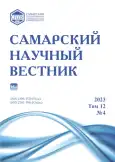Морфология Caragana arborescens Lam., интродуцированной на территории Волгоградской области, и состояние её прикроновых травянистых растительных сообществ
- Авторы: Исаков А.С.1, Кулик К.Н.1
-
Учреждения:
- Федеральный научный центр агроэкологии, комплексных мелиораций и защитного лесоразведения РАН
- Выпуск: Том 12, № 4 (2023)
- Страницы: 35-41
- Раздел: Биологические науки
- URL: https://journals.rcsi.science/2309-4370/article/view/260632
- DOI: https://doi.org/10.55355/snv2023124105
- ID: 260632
Цитировать
Полный текст
Аннотация
Изучение состояния кустарников юго-востока Европейской части России актуально в силу необходимости поддержания необходимого материала для защитного лесоразведения. Изучение их прикроновых растительных сообществ дает ценную информацию об экологических аспектах интродукции и успешной адаптации кустарников в месте массовых посадок. Целью исследования являлась оценка состояния Caragana arborescens, завезенной из Восточной Сибири и высаженной на засушливых территориях Волгоградской области, а также экологическая характеристика ее прикроновых травянистых растительных сообществ. На исследуемом участке выделено две группы растений – растущие на обычной почве и на почве с повышенным содержанием солей, цинка и пониженным содержанием марганца. В последнем случае C. arborescens имела относительно меньшие размеры, более редкую крону, сниженную способность к генерации побегов и устойчивость к болезням и вредителям. Растения C. arborescens чутко реагируют на антропогенную нагрузку, но в пределах анализируемой территории это не сопровождается прогрессирующей сукцессией экосистемы. Под кронами C. arborescens обнаруживается от 8–10 до 24 видов высших сосудистых растений с преобладанием одно- и двулетних форм. Девять видов претендовали на роль доминантов и субдоминантов прикроновых растительных сообществ, наиболее часто – представители семейств Asteraceae и Mareaceae. Обнаруженные сообщества демонстрировали явные признаки антропогенного воздействия, но без развития прогрессирующей сукцессии экосистемы.
Полный текст
Открыть статью на сайте журналаОб авторах
Артём Сергеевич Исаков
Федеральный научный центр агроэкологии, комплексных мелиораций и защитного лесоразведения РАН
Email: isakov-a@vfanc.ru
младший научный сотрудник лаборатории биотехнологии
Россия, г. ВолгоградКонстантин Николаевич Кулик
Федеральный научный центр агроэкологии, комплексных мелиораций и защитного лесоразведения РАН
Автор, ответственный за переписку.
Email: kulikk@vfanc.ru
доктор сельскохозяйственных наук, академик РАН, главный научный сотрудник лаборатории гидрологии агролесоландшафтов
Россия, г. ВолгоградСписок литературы
- Зонн И.С., Куст Г.С., Андреева О.В. Парадигма опустынивания: 40 лет развития и глобальных действий // Аридные экосистемы. 2017. № 3 (72). С. 3–16.
- Кулик К.Н., Беляев А.И., Пугачёва А.М. Роль защитного лесоразведения в борьбе с засухой и опустыниванием агроландшафтов // Аридные экосистемы. 2023. Т. 29, № 1 (94). С. 4–14.
- Крючков С.Н., Маттис Г.Я. Лесоразведение в засушливых условиях. Волгоград: ВНИАЛМИ, 2014. 300 с.
- Деградация земель и опустынивание в России: Новейшие подходы к анализу п поиску путей решения / гл. ред. Г.С. Куст. М.: Изд-во Перо, 2019. 235 с.
- Lynch A.J. Predictors of tree cover in residential open space: a multi-scale analysis of suburban Philadelphia // Urban Ecosystems. 2022. Vol. 25, № 2. P. 1515–1526.
- Виноградова Ю.К., Куклина А.Г. Морфобиологические признаки генеративной сферы некоторых таксонов рода Сaragana fabr. в условиях интродукции // Бюллетень Главного ботанического сада. 2013. № 2 (199). С. 27–31.
- Трещевская Э.И., Тихонова Е.Н., Голядкина И.В., Трещевская С.В., Князев В.И. Карагана древовидная (Caragana arborescens Lam.) как кустарниковая порода при биологической рекультивации техногенных ландшафтов // Лесотехнический журнал. 2021. Т. 11, № 3. С. 31–44.
- Huang W., Zhao X., Zhao X., Li Y., Lian J. Effects of environmental factors on genetic diversity of Caragana microphylla in Horqin Sandy Land, northeast China // Ecology and Evolution. 2016. Vol. 6, № 22. P. 8256–8266.
- Wang Z., Xie L., Prather C.M., Guo H., Han G., Ma C. What drives the shift between sexual and clonal reproduction of Caragana stenophylla along a climatic aridity gradient? // BMC Plant Biology. 2018. Vol. 18, № 1. doi: 10.1186/s12870-018-1313-6.
- Иозус А.П., Завьялов А.А., Крючков С.Н. Биоэкологическая характеристика древесных видов в условиях выращивания в сухой степи // Международный журнал прикладных и фундаментальных исследований. 2018. № 10. С. 131–134.
- Кулик К.Н., Пугачева А.М. Структура растительных сообществ залежных земель в системе куртинных защитных лесных насаждений в сухих степях // Аридные экосистемы. 2016. Т. 22, № 1 (66). С. 77–85.
- Протасова М.В., Проценко Е.П., Петрова И.В., Петров С.С., Сабр С.Ф. Использование методов биоиндикации при исследовании экологического состояния городской среды // Экология урбанизированных территорий. 2019. № 3. С. 136–140.
- Тиходеева М.Ю., Лебедева В.Х. Практическая геоботаника. Анализ состава растительных сообществ. СПб.: Изд-во Санкт-Петербургского ун-та, 2015. 166 с.
- Hudson L.N., Newbold T., Contu S., Hill S.L.L., Lysenko I., De Palma A., et al. The database of the PREDICTS (Projecting Responses of Ecological Diversity In Changing Terrestrial Systems) project // Ecology and Evolution. 2017. Vol. 7, № 1. P. 145–188.
- Маевский П.Ф. Флора средней полосы европейской части России. 11-е изд., испр. и доп. М.: Товарищество научных изданий КМК, 2014. 635 с.
- Василевич В.И. Доминантно-флористический подход к выделению растительных ассоциаций // Ботанический журнал. 1995. Т. 80, № 6. С. 28–41.
- Егоров С.А., Крючков С.Н., Солонкин А.В., Соломенцева А.С., Романенко А.К., Горбушова Д.А. Особенности адаптации древесных и кустарниковых видов в архиве популяций и клонов насаждений г. Волгограда // Научно-агрономический журнал. 2023. № 3 (122). С. 60–67.
- Pugacheva A.M. Climatic fluctuation in dry steppes and their role in the demutation process // Arid Ecosystems. 2020. Vol. 10, iss. 3. P. 181–187. doi: 10.1134/s2079096120030063.
- Иванцова Е.А., Новочадов В.В. Характер взаимодействия компонентов антропогенно-трансформированных экосистем Юга России // Известия Нижневолжского агроуниверситетского комплекса. 2019. № 3 (55). С. 79–86.
- Cai Y., Zhao M., Shi Y., Khan I. Assessing restoration benefit of grassland ecosystem incorporating preference heterogeneity empirical data from Inner Mongolia Autonomous Region // Ecological Indicators. 2020. Vol. 117. doi: 10.1016/j.ecolind.2020.106705.
Дополнительные файлы










